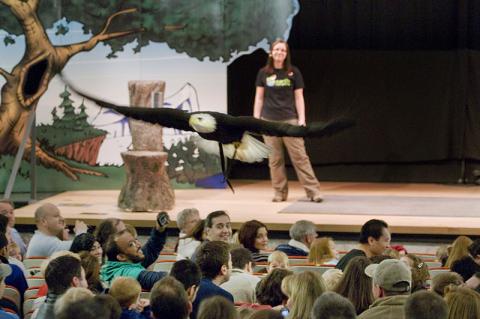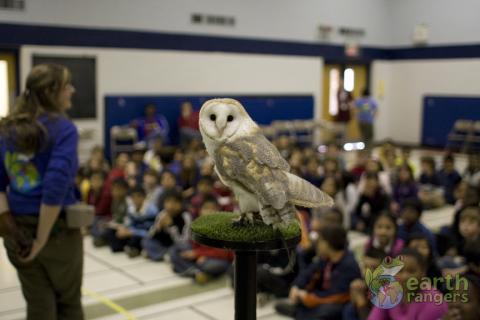
Can kids come to the rescue of our endangered wildlife? Woodbridge, Ont.-based non-profit Earth Rangers educates and empowers young people to become involved, giving them the ammo they need to care and act.
Its colourful comprehensive website has games, videos, contests and online rewards for Bring Back The Wild, the kid-powered fundraising campaign launched in 2010 in collaboration with Nature Conservancy Canada that empowers kids to help protect animals and their habitats.
“Our focus is to communicate to children a positive science-based message on the importance of protecting biodiversity and adopting more sustainable behaviours,” it states in the “about” section of the site.
The organization reaches hundreds of thousands of children through interactive live animal shows performed in schools, at Toronto’s Royal Ontario Museum and at community events. It also engages kids through a national outreach campaign on YTV and via more than 100,000 Earth Rangers.
“It’s not something that’s being forced on them by teachers ,” Earth Rangers executive director and co-CEO Peter Kendall tells www.samaritanmag.com. “It’s amazing the letters we get from parents. One parent wrote how she cried when she realized her child was getting involved in trying to help.”
Here are the facts: an estimated 25 percent of mammals, 31 percent of reptiles and 33 percent of amphibians are threatened with extinction and one of their greatest threats is habitat loss. These stats on the Earth Rangers website and other alarming numbers — 60 percent of the world’s ecosystems degraded; 50 percent of the world’s forests gone — aren’t designed to scare, rather to appeal to children to make a difference.
Formed in 2004, the idea for Earth Rangers, Kendall says, stemmed from his work with The Schad Foundation, set up by Robert Schad to donate financial aid annually to environmental causes around the world from Grizzly bears on the Kamchatka Peninsula to the Ecological Farmer’s Association of Ontario. As executive director, Kendall helped developed and run a program in conjunction with schools in California, which included taking various animals into the classroom.

“I saw the powerful effect of using animals on children and we wanted to bring that home to Canada,” says Kendall.
“The program started growing very quickly. We needed to find a focus. So we did a large research study of children in Canada and across North America. What would motivate them to get involved? Without question, the most important issue that emerged was animal habitat.”
In 2010, Bring Back the Wild was launched. The program involves children by having them create and run fundraising events and opportunities. The money raised goes towards specific projects selected and instituted in a partnership with Nature Conservancy Canada, a charity that has been working for almost a half century to help protect more than 800,000 hectares of land across the country.
Children select the specific animal they’d like to help with the money they raise. Current projects include protecting bison in Saskatchewan, monarch butterflies in Manitoba, the pine marten in Newfoundland and the spotted turtle in “secret locations” in Ontario.
The projects are diverse and sometimes complex. The spotted turtle, for example, is threatened not only by vanishing wetlands, but by invasive species that destroy the natural balance of the sensitive areas where they live. Previous endeavours aided the peregrine falcon, wolverine, grizzly bear and Jefferson salamander.
Half the monies go directly to supporting the habitat in question, while the other half goes towards specific educational projects that raise awareness of the issue with other children — hopefully garnering even more support.
Kids respond to the practicality of the approach and get a real sense of making a difference.

Kendall mentions the power of social media in spreading the word, including a Facebook page with more than 22,000 “likes” and a Twitter account. “A lot of content gets consumed with the child and their parents,” he says. The organization also walks the walk in its own “home” with an office that features cutting-edge energy efficient technology.
When it comes to the educational portion of Earth Ranger’s activities, the show still starts with live animals.
“It’s a powerful way to connect with kids,” Kendall says.
Earth Rangers takes various types of animals into the classroom. They might begin with lemurs and start with a talk about natural history, including what’s happening to the animal’s natural habitat right now. In the case of lemurs, unfortunately the outlook really is grim, with their native Madagascar undergoing rapid deforestation. Children begin to see another side to the cute and engaging creatures. “Kids connect with this emotionally,” Kendall says.
Habitat and conservation also get a more local focus, including a talk about the still forested regions of Canada and their importance internationally. “We have a responsibility to protect that,” he says.
Once the connection is made between animals, habitat and the environment, the message is developed. “Then we pull out our ‘animals of hope’ — we bring out a bald eagle,” Kendall explains. The bald eagle’s inspiring story of recovery from the brink of extinction represents a concrete example of how taking specific and targeted actions, like banning DDT and protecting their environment, have brought positive results.
The young audience leaves feeling the urgency of the situation, but also empowered to act. “The message is, if we work together, there are things that we can accomplish, so that they are empowered to act,” Kendall says.
Jordan Ανδρικά • Summer SALE έως -50%